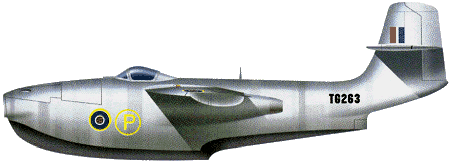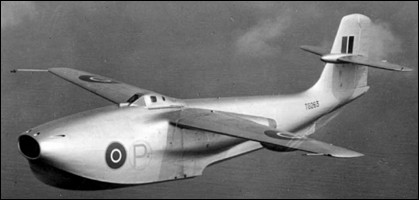|
| Conceived as a means of applying the promised advantages
of jet propulsion to a single-seat fighter flying
boat for use in the Pacific, the SR.44 was proposed by
Saunders-Roe (Saro) during 1943. This proposal led to a
contract for three prototypes being placed in May 1944
to Specification E.6/44. To be designated SR.A/1 before
first flight, the fighter was of light alloy construction
throughout, power being provided by two Metropolitan
Vickers F2/4 Beryl turbojets and provision being
made for an armament of four 20mm cannon grouped
in the forward hull above the air intake. The first SR.A/1
did not fly until 16 July 1947, its Beryl turbojets each being rated at 1465kg. The second flew
on 30 April 1948 with 1587kg Beryls and
the third followed on 17 August of that year with fully rated
Beryls of 1746kg. As no operational
requirement remained for a fighter flying boat, official
interest waned, and, after a brief revival of interest
during the Korean War, the last surviving SR.A/1 was
retired in June 1951. FACTS AND FIGURES © The axial-flow Beryl engine was
chosen because two of them could
be mounted side-by-side in a
relatively narrow fuselage. © The position of the small cockpit
enclosure on the fuselage meant that
the pilot's view ahead disappeared
during the take-off run. © The possibility of water ingestion into
the nose-mounted intake was the
reason for its high position in the nose.

| MODEL | SR.A/1 |
| CREW | 1 |
| ENGINE | 2 x Metropolitan-Vickers F2/4 Beryl turbojets, 1474-1746kg |
| WEIGHTS |
| Take-off weight | 8633 kg | 19033 lb |
| Empty weight | 5108 kg | 11261 lb |
| DIMENSIONS |
| Wingspan | 14.02 m | 46 ft 0 in |
| Length | 15.24 m | 50 ft 0 in |
| Height | 5.11 m | 17 ft 9 in |
| Wing area | 38.60 m2 | 415.49 sq ft |
| PERFORMANCE |
| Max. speed | 824 km/h | 512 mph |
 | A three-view drawing (1685 x 1120) |
| grahamclayton, e-mail, 07.05.2023 09:30 Once could say that the jet-powered floatplane fighter concept was a bit of a dead-end :-) reply | | RICHARD W FRANKLIN, e-mail, 19.06.2022 21:03 My father was engineer on one of the RAF Marine Craft section boats and was based at Felixstowe. He told me that one of the craft was sent to locate the crashed SRA1 and dropped the anchor which amazing actually hooked into, presumably part the airframe, of the aircraft. reply | | Ralph Hopkin, e-mail, 23.03.2017 06:43 I was an apprentice at Saunders Roe in 1946. Along with some other youths we made a series of "chine gauges used in construction. I still don't know what they were. We just made them but I was inside the hull before the engines were installed. I remember lying on my belly looking out of the air intake. Also worked on functional display model to show float to Tati on and retraction. Powered by a 1 /4 hP drill motor! Wonder where it ended up. reply | | Colin Morris, e-mail, 16.04.2016 18:51 Recently seen it at SolentSky in Southampton from balcony you can even look into cockpit really interesting museum reply | |
| | Roger Chapman, e-mail, 30.04.2015 13:00 For such an innovative design there is remarkably little information to be found on the web. It was after all the fastest jet seaplane in the world for a while. This is the first place I have found that gives details of the crash in Harwich Harbour.
My interest in the case - as a 5 year old boy I was watching the flight with my father from the balcony of our flat in Dovercourt but had become bored and gone back inside shortly before the crash.
My father supplied the authorities a compass bearing to try to help the search for the wreck but I do not know whether they found it useful. reply | | paul scott, e-mail, 10.04.2013 03:35 Another of the strange post-war British jet designs, great to have even just a photo of it! reply | | Eric G.Jolliffe, e-mail, 11.01.2013 01:03 The SRA /1 Auto Observer
It was of interest to note that before the Black Box data recorders were introduced the system of instument monitoring on the SRA /1 was made in what was called the "Auto Observer", this took the form of a duplication of essential metering in an enclosed secure box which was recorded by a cine camera during the flight testing period.This involved work intensive rerouting of many services, pipe work, and electrical wiring through the box situated between the two engines. reply | | leonard Brett, e-mail, 15.07.2011 23:09 I worked on these planes at Saunders- Roe and went to the Festival of Britain in 1951 with 263 when Tyson landed it on the Thames, I was the radio man and have pictures of the plane landing and being towed up to Tower brdge. reply | | Klaatu, e-mail, 23.06.2011 17:28 This aircraft was intended for service in the Far East, to be operated against the Japanese from rivers and lagoons in Burma and Malaya. However, by the time it was completed, the war was over and it was no longer required. reply | | Nick Dean, e-mail, 31.05.2011 13:11 There is an example of this aircraft at the Imperial War Museum Duxford!. reply | | david allard, e-mail, 20.07.2010 22:43 I happened to be doing my National Service as a truck driver at Felixstowe when the Squirt as it was known was being flown. It is my understanding that I drove the hearse at the funeral of a pilot whose SRA! crashed. I was at Felixstow when TG267 was lost The only other aircraft flying at Felixstowe at that time were Sunderlands none of which crashed
10be doing my National Service a Felixstowe when the Squirt as it was known was being flown
How many SRA1 were there?
I have always believed that I drove the hearse for one of the pilots lost when reply | | Penny Cockburn ex Major, e-mail, 13.08.2010 17:26 My father was the pilot of TG 267 which crashed at Felixstowe in 1949.I have found this website by accident as I have been trying to find info on my Dad. reply | | Emanuele, e-mail, 01.05.2010 15:28 for: Derek Horsey: the TG263 eas displayed on the Thames during the Festival of Britain celebrations in June 1951, with class B registration G-12-1. reply | | Derek Horsey, e-mail, 24.02.2010 20:57 Does anyone know the registration of, and date the one came up the River Thames and moored in the Pool of London.
Assume it was 1951 but.....? reply | |
| | Bill Devins, e-mail, 04.02.2010 20:19 Chief Naval Test Pilot Lt Cmdr Eric "Winkle" Brown flew the third SR A /1, TG271, for the first and only time on 12 Aug 1949 at the behest of Saunders-Roe. He wrung out the tubby little 'boat, reaching Mach .82, pretty much the top speed of the SR A /1, in a dive. On landing, a submerged log holed the front hull and ripped off the starboard stabilizing float. Despite his best efforts, Brown could not keep the starboard wing from digging in and cartwheeling TG271 onto its back. Struggling free underwater, Brown almost succumbed, but was held up by Geoffrey Tyson, the Saro test pilot responsible for the majority of the SR A /1 testing, who had leapt off the supporting launch when he saw Brown in trouble. Despite extensive searching, the sunken third SR A /1 prototype was never located.
TG267, the second SR A /1 prototype, was lost on 17 September 1949, a public "At Home" day for RAF Felixstowe. Squadron Leader 'Pete' Major took TG267 up that morning to prepare for the aerobatic routine he planned to perform for the public that afternoon. During a slow roll, he let the nose slip down while inverted, then instinctively pulled on the stick rather than pushing out from his upside-down position. The aircraft broke up on impact, and no trace of Major was found; much of the aircraft was salvaged over the next ten days.
The completely restored first prototype, TG263, resides today at the Southampton Hall of Aviation, along with an example of its ejection seat (the first delivered by Martin-Baker to an aircraft manufacturer) and a MetroVick Beryl pwerplant, both exhibited outside the airframe. reply | | darren wood, e-mail, 11.11.2009 14:35 i know that eric brown the test pilot flew one and on landing on the river median? hit a large log floating in the water.he survived but only after geoffrey tyson dived in fully clothed and rescured him. reply | | Kevin Tegg, e-mail, 16.10.2009 15:05 At an 'aviation day' in Felixstowe, I witnessed the crash of an SRA1. After several passes along the shore front, it dived gently into the sea with no apparent prior problem. What was the cause? reply | | Sgt.KAR98, 27.12.2007 00:44 What was the size of this plane? reply | | Corsairoz, e-mail, 04.12.2007 20:19 The last remaining SRA-1 is still in perfect condition and survives in Solentsky Museum in Southampton UK. reply |
|
Do you have any comments?
|
| 
COMPANY
PROFILE
All the World's Rotorcraft
|








